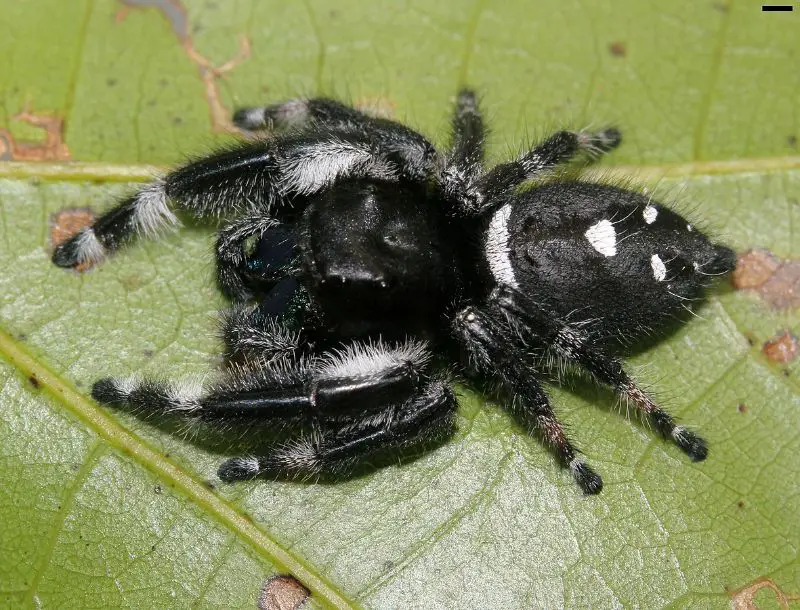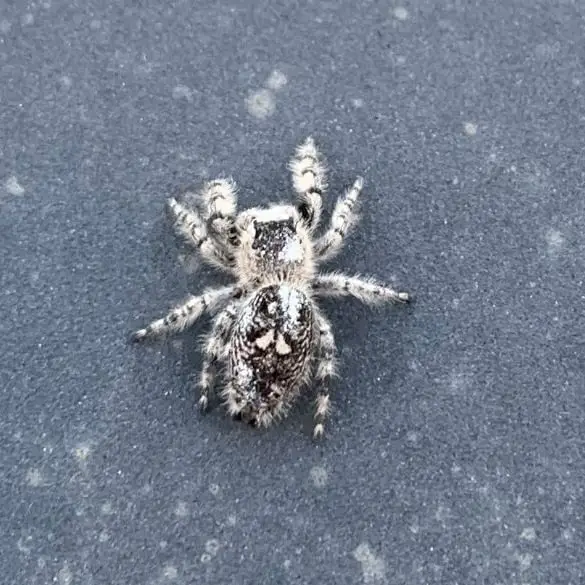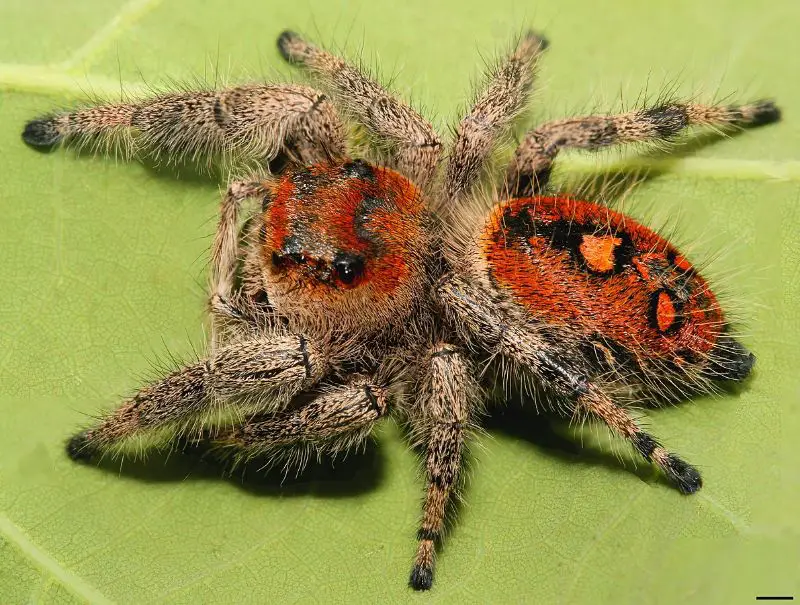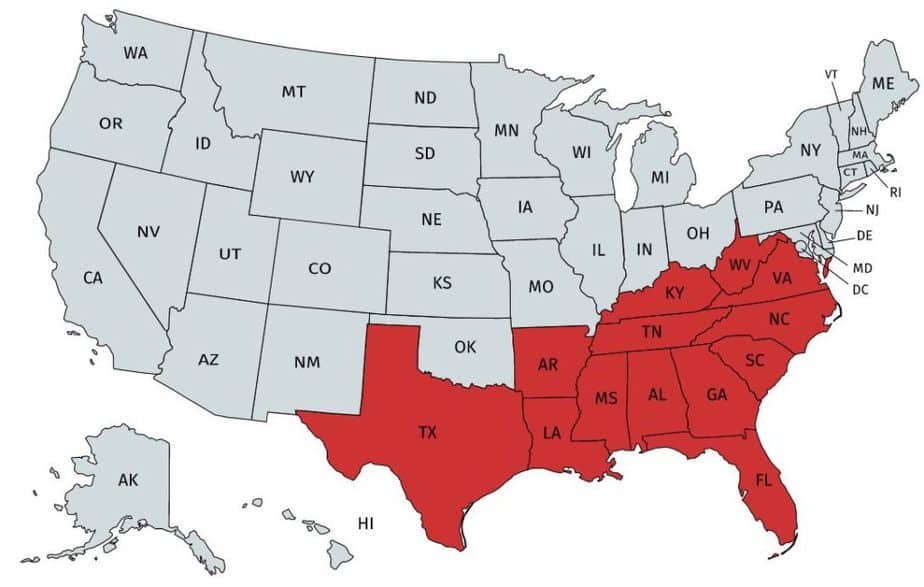Phidippus regius, the regal jumping spider, is one of the largest species of the jumping spiders of the Phidippus genera. It occurs mostly in the Southeastern United States as well as the Caribbean and the Easter Islands. The largest share of its population can be found in the state of Florida. Over the last years, the spider has been introduced and established populations in the Western United States as well as on Hawaii.
Description of the Regal Jumping Spider
The regal jumping spider comes in three different appearances.
The male is always black with white bands around its legs. On its back, there are usually three white spots and a white stripe around the top of its abdomen. The white spots often resemble a smiley face – there are two almond-shaped or round spots at the end of the abdomen and a larger, triangular shape closer to the cephalothorax (head) that often looks like a mouth. The male can often be confused with the similar looking Daring Jumping Spider. If the spots on the back of the abdomen are orange, it is most likely a daring jumping spider.

The female comes in two appearances that are easier to identify.
The gray form of the female is mostly gray with some black bands on its legs and markings on the abdomen.

The orange form female has an orange-colored abdomen and cephalothorax while the legs look similar of the gray form female.

Size
The average females reach a body size of 0.6 inches (15 mm) and can grow up to 0.9 inches (22 mm). Males are slightly smaller and can reach a size of up to 0.7 inches (18 mm). Phidippus regius is therefore one of the largest jumping spiders found in the United States.
Web
As other jumping spider species, the regal jumping spider is a hunting spider and does not spin a web to catch prey. They only time they build a web is before a long or deep jump. With this “safety line”, their fall will end softly, if something goes wrong with the jump
Bites
As other jumping spiders, the regal spider usually runs away to hide rather than attack a human. While there are cases where people get bit, the bites are not a medical concern. They usually cause some local pain and swelling. At worst, it may lead to a mild headache and nausea which will pass.
Scientific Classification of Phidippus regius
- Kingdom: Animalia
- Phylum: Arthropoda
- Subphylum: Chelicerata
- Class: Arachnida
- Order: Araneae
- Infraorder: Araneomorphae
- Family: Salticidae
- Genus: Phidippus
- Species: Phidippus regius
Distribution of the Regal Jumping Spider in the USA

The regal jumping spider can be found in the Southeastern and Western United States, most often in Florida and in these states: Alabama, Arkansas, California, Georgia, Kentucky, Louisiana, Mississippi, North Carolina, South Carolina, Tennessee, Virginia, West Virginia.
References:
- Taxon details: World Spider Catalogue
- Binomial name from: Koch, 1846
- http://entnemdept.ufl.edu/creatures/misc/regal_jumping_spider.htm


Late June 2021
Denver, CO
Concrete bridge over Platte river
Body 12mm
Hello Doug, thanks for uploading this picture. This is a bold jumper, Phidippus audax: https://usaspiders.com/phidippus-audax-daring-jumping-spider/
Phidippus carolinensis
Found this spider several years ago when I lived in Clermont, FL. It was on the inside of my screened-in porch, which is weird because I don’t know how it managed to capture the butterfly. There were no holes in my screens. I don’t remember the time of year that I found it.
Hello Andrew, thank you for uploading this great shot! This is a female regal jumping spider (Phidippus regius) in its orange form. It appears to be gravid. You can find more information about it here: https://usaspiders.com/phidippus-regius-regal-jumping-spider/
Felt this one crawling on my arm today here In Matthews NC.
Hopefully this rasta capped (lin appearance) looking spider is not venomous. However, what is the thought on this character?
if you are in Cali it is a Phidippus adumbratus
• Black. Small – medium. Marking on abdomen almost looks like a cream-colored heart. Found crawling on wall. No web, but spinners on back.
• Banded legs. Banded body.
Fort Dodge, Iowa
• Nik
Hello Nik, thanks for getting in touch! Ths is a male Phidippus sp. jumping spider. I am unable to tell the exact species, it might be Phidippus audax, P. regius or P. putnami.
It’s not phidippus regius. We don’t have those in Iowa. The markings are unusual, and it’s difficult to tell. My initial impression is audax because they’re prevalent in Iowa. However, some of the markings appear more like stripes than two dashes. Also, the iridescent patch between the two most prominent white markings is throwing me. I wish I could tell the color. Some species have metallic green markings. Putnami seems possible, but the center markings don’t fit. I almost wonder if it’s a cross-breed.
I found one in New Mexico yesterday 🕷️ I brought him outside since it is not freezing here anymore.
What is it it said it is not from southern Utah so I’m not sure if it is the jumping spider but it does jump
This is very small and has one larger and two smaller white dots on its back.
Hello Polly, this is definitely a harmless jumping spider in the genus Phidippus. Assuming you are located somewhere in the Southeastern U.S., this is most likely a regal jumping spider (Phidippus regius): https://usaspiders.com/phidippus-regius-regal-jumping-spider/
You are just straight up bad at this arent you USA spiders 🙁
Which jumping spider is this?
I am not at all sure if this is a jumping spider. It was very small. Perhaps it was a juvenile.
I think it’s a female Hentzia Mitrata
Can anyone identify this spider?
Phidippus otiosus
Looks like phidippus Otiosus
Can you help me identify this spider that I found in my mother’s back yard
What type of jumping spider is this he/she is so beautiful
Hello Taylor, this is most certainly a Phidippus sp. jumping spider – Phidippus regius would also be my best guess for a species-level identification.
This is a Phidippus otiosus. Btw USA Spiders website your “white regius” is also a Phidippus otiosus
I have this jumping white/Grey spider inside my car!
How do I trap & get it out ?
Found several of the black with white stripe spiders in our yard in Creswell Oregon.
Hello Bob, this is a regal jumping spider (Phidippus regius): https://usaspiders.com/phidippus-regius-regal-jumping-spider/
No it’s not. It’s an audax. Use iNaturalist.org please. You clearly do not know your jumping spiders. Also your regius map is way off.
😂😂😂I thought the same thing
This spider was found in Greeley, CO. It is black and white. It is hairy. It could fit on a penny. I looks similar to some kind of jumping spider, or maybe a zebra spider. I think it has short legs with alternating color pattern. Sorry I couldn’t get a more clear photo, it was too fast for me!
This spider was found in Greeley, CO. It is black and white. It is hairy. It could fit on a penny. I looks similar to some kind of jumping spider, or maybe a zebra spider. I think it has short legs with alternating color pattern. Sorry I couldn’t get a more clear photo, it was too fast for me!
This is the second photo
Hello Devon, yes, this is some type of jumping spider – fairly certainly in the genus Phidippus, possibly Phidippus regius: https://usaspiders.com/phidippus-regius-regal-jumping-spider/
Oh ffs. This is a Phidippus audax bryantae variation
🤣🤣🤣 I have been laughing my way through this website and comments as well and was thinking wow how is it even possible for USA spiders to get everything so wrong 🤣🤣🤣
Not really sure what this spider is. Found it in Vancouver, BC. Picture is kinda blurry, sorry about that. If It can be identified that would be great. Thanks 🙂
Just had an encounter with one, was closing my garage door I saw it n thought this guy looks really cool. Got close n saw what appeared to b a face on it’s back. I didn’t provoke it n I didn’t harm or kill it. I was taught spiders r nature’s exterminator so I don’t kill them. I just observed it for a minute then walked away. What a cool experience.
Found on palm tree in South Carolina
Found this cute, little thing on my patio. It even let me hold it. Then it jumped off, with a web.
Found her today on my hydro garden outside! Central FL!